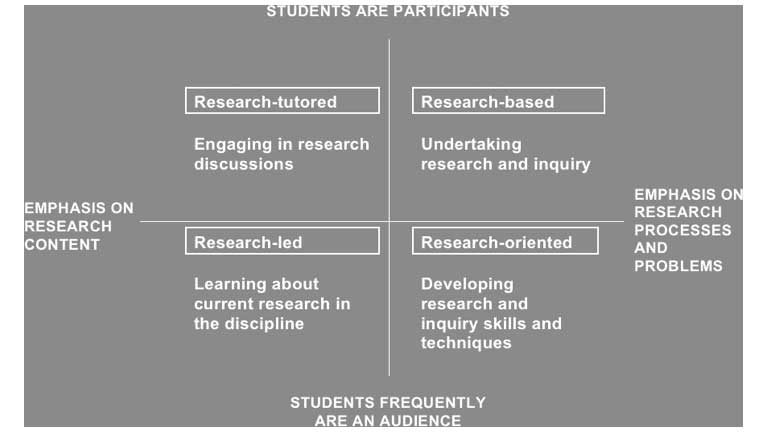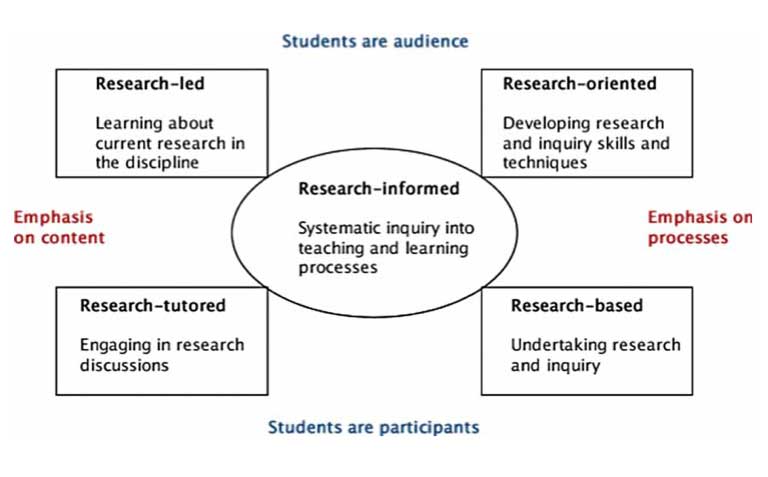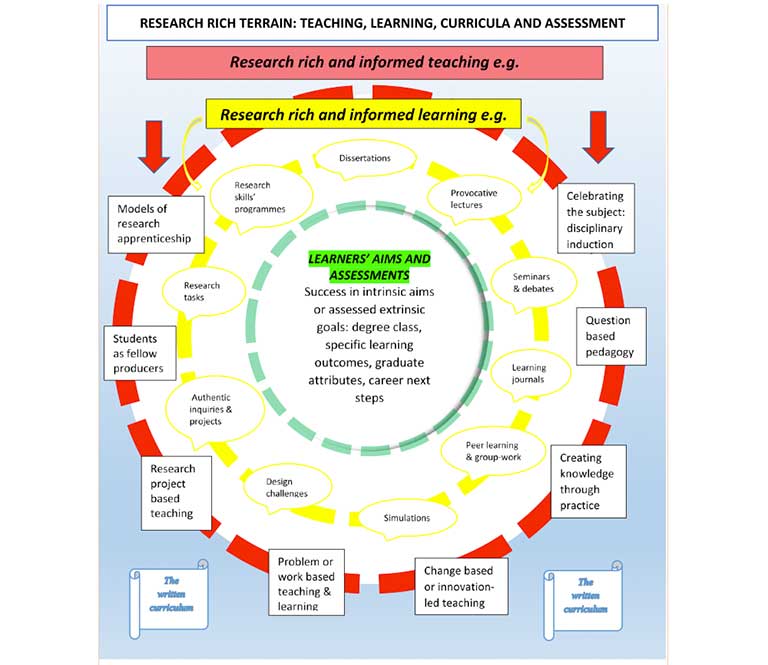Looking to the future
Research rich and informed teaching
Dr Grant Bage - School of Education, University of Hertfordshire

Abstract
As a recently-appointed University of Hertfordshire Research Fellow in research rich and informed teaching in higher education, I am exploring these questions: what does this phrase mean? How have others approached its research? How might I build on their work? This process is fleshed out by considering explanations from the sector about its importance, examining three recent (2014-16) literature reviews and reviewing the background and development of an influential diagrammatic model of ‘undergraduate research and inquiry’ produced by Healey and Jenkins (2009). The article concludes by offering ‘a map of the terrain’, research questions with which to explore that map and contact details to find out more.
The significance of research rich and informed teaching
There is a longstanding sentiment amongst most educators, participants and policymakers in higher education that linking teaching and research improves educational practice. For example the University of Hertfordshire’s graduate attributes describe an ambition to be ‘internationally renowned for research-rich education that produces creative, professional and enterprising graduates by providing expert teaching informed by research, business and the professions.’ Other Universities share such aspirations. The University Alliance represents 20 ‘city and regional’ institutions similar to Hertfordshire. For its chief executive, ‘the positive interplay between research and teaching is one of the defining aspects of higher education’. (UA/HEA 2016: 1) Such sentiments are not simply altruistic. In a crowded market place, in which competition is fierce not just between universities but between different models of further and higher education (apprenticeships, virtual provision, vocational courses etc.), the incentive of offering students access to research skills and knowledge offers higher education distinct market advantages. Forging productive links between research and teaching is also often presented as socially beneficial. The UK-based Higher Education Academy’s leader, for example, explains how her organisation ‘champions and promotes excellent teaching … and research-informed teaching is increasingly becoming a key concern, globally, as such approaches serve both students and society well.’ (UA/HEA 2016: 1). Even Europe’s research-richest universities, with the highest proportion of income from research compared to teaching, acknowledge ‘a growing interest in creating greater synergies between research and student education at undergraduate level.’ (Fung et al,2017:5)
For individual students and teachers, for universities and for society at large, the capacity of higher education to link teaching with research seems to be a high-stakes activity. What might educational research itself tell us about the field?
Insights from recent literature reviews around research rich and informed teaching
One commentator recently claimed it was a ‘bitter irony that unquestioning defendants of research-led education have limited evidence to support its effectiveness’ (Morris, 2017). Is that fair? A systematic review of English language publications on ‘the research-teaching nexus’ in higher education (Tight, 2016) analysed 34 books or articles with that exact term in their titles, and another 65 titles using the words ‘research’ and ‘teaching’. It defined the research-teaching nexus as an ‘idea (which) recognizes the two key functions of higher education – teaching and research – and argues that they are, or should be, closely linked’ (Tight 2016:1).
The review expressed disappointment about the poor progress made by educational research in articulating how such linkages happened in practice. From the 1970s to the 1990s ‘large scale, quantitative and mainly American studies’ (ibid: 3) using ‘available institutional or national data sets … found either no association or a small positive correlation’ (ibid: 4). More recent UK and global research ‘tended to be qualitative’ with a perceived weakness of being ‘overly-focused on the opinions expressed by academics during interviews’; although the ‘application of phenomenography’ might promise a more ‘fruitful methodological avenue’ for future studies (ibid: 10). The review concluded:
All these analyses would seem to confirm … in general there is no simple and consistent linkage between research and teaching; and that where such a link does exist, it may be found in varied and complex ways, and where it does not it may require considerable efforts to generate and maintain (Tight 2016: 9).
Nor is that a lone voice. Another recent ‘bibliographic review’ around ‘the role of the research-teaching link in higher education’ (Malcolm, 2014: 289) cited 103 works. Although only 33 of these overlapped with Tight’s 2016 sample, the study similarly concluded:
…there is little evidence that an increasingly informed understanding of the possibility and potential of a research-teaching link has exercised a systemic influence on teaching and learning (Malcolm, 2014: 294).
It appears to have been difficult for educational research to pin down, in ways that are reliable and therefore persuasive across settings and disciplines, how and why teaching-research links are beneficial; and so also, how they might systematically and developmentally be encouraged to multiply. Why?
An obvious difficulty is that terms like teaching and research are common, generic, variously used as verbs, nouns, gerunds and adjectives, and deployed in everyday speech as well as professional and research dialogues. Surely therefore, everyone knows what they mean? Yet their very ubiquity works against universal precision, and how these words are read in theory or embodied in practice appears heavily contextualised. This is made clear in a third review, a systematic Norwegian study of 200 pieces of international research literature published since 2000 on ‘the relationship between research and education’ in higher education (Elken and Wollscheid 2016: 46). This describes the ‘ambiguous and sometimes contradictory empirical results’ (ibid: 3) obtained from multiple, international educational research endeavours. What one study or project meant by and found out about ‘research’ could not simply be assumed to translate to another setting:
The relationship between research and education is highly dependent on the definitions of research and education. These are terms that are broadly used, but with quite different meanings dependent on the context.’ (ibid: 15-16 my italics; see also Griffiths, 2004: 714).
We should not be surprised. University teaching exists to advance people’s education across multiple disciplines. University research exists to extend, synthesise and occasionally to transform the knowledge that comprises those disciplines. Higher education, when focused on the research-teaching relationship and as portrayed in the three literature reviews cited above, is therefore a complex and diverse epistemological exercise.
Any superficial survey of a University prospectus emphasises such diversity. For example the 10 Schools of the University of Hertfordshire (UH) each represent significant, diverse areas of human endeavour and knowledge. Research and teaching about the ‘astrophysics of stars, galaxies and black holes’ is radically different in nature to ‘design and material culture in the 20th century’. Different disciplines also often have different epistemological and educational starting points for what they mean by research and teaching, as this 2007 Higher Education Authority guide makes clear:
There are important disciplinary and interdisciplinary variations in teaching-research relations … shaped by how disciplinary communities conceive the nature of knowledge, research and teaching; the forms of pedagogy and curricula in different disciplines; the nature of research activity and its organisation; and, for some disciplines, the impact of professional organisations and student interests on the content and practices of the disciplines (Jenkins et al., 2007: 35).
When looking ourselves at research-teaching links what might be done to overcome such multiple complexities, whilst simultaneously drawing from previous work?
Insights from strategic and diagrammatic thinking
The ‘suggested strategies’ of Jenkins et al (2007) had mixed origins,arising from:
our review of the research evidence, in particular at department level … and from considering the available evidence from practice and policy. We do caution that … there is only a limited number of research studies at this level and most of the interventions have been little researched (ibid: 51-2 my italics).
Tight (2016: 7) places their publication in an ‘advisory sub-genre’ on teaching-research links, to which Jenkins and Healey have made many contributions (e.g. Healey and Jenkins, 2009; Healey, Jenkins and Lea, 2014; Healey, Flint and Harrington, 2014; Jenkins and Healey, 2005). Another example Developing Undergraduate Research and Inquiry (Healey and Jenkins, 2009), was commissioned by the HEA as part of a series looking at the relationship between teaching and research. It currently receives around 19,000 citations when searched for in Google Scholar and shortly after publication was summarised by an academic journal’s book critic as ‘a comprehensive review of good practice’ (Pilkington, 2010: 247). That reviewer describes how Healey and Jenkins open the publication with their visual, diagrammatic model (Figure 1) of ‘research informed teaching … with its two axes of seeing’.
Figure 1 - The Nature of Undergraduate Research and Inquiry
(Source: Healey and Jenkins, 2009: 7)

Elken and Wollscheid’s 2016 literature review describes Figure 1’s diagram as ‘the most prominent model’ in the field and reports that ‘to date the model remains highly cited in articles that deal with the relationship of research and education’ (ibid: 16). But from what sort of knowledge does this model derive? For Healey and Jenkins the publication in which this model appeared as the introduction’s centrepiece, was primarily developmental and for ‘enhancing practice and policy’. Its arguments grew only ‘in part out of the international research evidence on teaching and discipline-based research and teaching relationships’ (Healey and Jenkins, 2009: 113, my italics).
The publication’s main foundations were 37 diverse, individual and international case studies of practice and 48 further illustrative examples. Most were connected by shared beliefs in, and common foci on, evidence exploring ‘undergraduate research and inquiry’. Equally these case studies and examples did not adopt similar research approaches, address common research questions nor in most cases, introduce critical or even agnostic thinking about the efficacy of linking teaching and research. As its authors admitted:
Research shows that, while for many academics the distinguishing feature of higher education should be the interconnection between teaching and discipline-based research, this is often not readily revealed in practice and, most significantly here, is not easily identifiable in the student experience of the curriculum (ibid, my italics).
Healey and Jenkins also carefully circumscribed knowledge claims made about their (now) ubiquitous diagrammatic model (Figure 1). For them that model represented a developmental tool, more than a claim to research knowledge:
It is useful because it gives a language for people to talk about the different ways in which they may introduce their students to research and inquiry … course teams may come up with different definitions of the four ways of engaging students in research and inquiry that are more appropriate for their context. The process of discussing and auditing their activities is where the value lies (ibid: 7-8 my italics).
Healey and Jenkins’ model was not designed as, nor claimed to be, a definitive production from research knowledge. Subsequently it has also been added to and critiqued. For example Ozay (2012) in a largely theoretical article, borrowed from Griffiths’ empirics (2004) to add a fifth oval. Entitled ‘research-informed’ that oval was placed at the centre of Healey and Jenkins’ existing quadrants, as shown in Figure 2.
Figure 2 - Dimensions of research in undergraduate learning
(Source: Ozay 2012: 460)

This Ozay/Griffiths oval addition offers two powerful ideas. It implies university educators should be actively developing and researching teaching and learning processes. It also nods to (without referencing) an educational definition by Stenhouse (1978:1) of research as ‘systematic inquiry made public’ i.e. a public and collaborative testing of claims (ibid: 2 my italics). Both ideas underpin the final diagrammatic model of this article, which I introduce as Figure 3 in the section that follows.
Map of research rich terrain
The model in Figure 3 has been developed partly to set Healey and Jenkins’ 2009 model (Figure 1) in a broader context, but also to respond to critiques of them. Brew claims Healey and Jenkins
...do not explore the consequences of conflating curriculum and pedagogy. Indeed, they do not distinguish them. However this is an important distinction … because while pedagogical decisions are likely to be the preserve of the person teaching the course or subject, curriculum decisions are often taken at a departmental or even institutional level … this highlights important questions about the power teachers do or do not have and who or what has the authority to decide on particular aspects of teaching and learning. (Brew 2013: 608).
Brew’s ‘do not distinguish them’ phrase seems unfair. In their 2009 report and elsewhere (e.g. Jenkins et al 2007) Healey and Jenkins clearly make the case for higher education teachers to be engaged in curriculum design and development. Yet her warning about the temptations of conflating pedagogy and curriculum is valuable given that in this field, as the three previously cited literature reviews have intimated, terminological and epistemological uncertainties abound. Fiercely-held value positions may also add more heat than light:
We might do well to limit the emotional commitment often embodied in thinking about the association between research and teaching, and do more to explore in detail what actually happens in practice (Tight 2016: 1).
Understanding and advancing, as well as researching and developing, how teaching and research can be linked to benefit students may therefore benefit from finer grained and multi-disciplinary observations of how the complex processes of pedagogy and learning interact: with each other, with individual learners, with the development and interpretation of curricula, and with assessment practices and outcomes.
These interactions pose complex practical and methodological problems. Yet it is worth recalling that, for higher education lecturers as for teachers of any age range, education as a human practice at its heart renders daunting challenges into soluble forms. Practitioners often conceptualise higher education’s complex work in a holistic way, not just to render it accessible to learners but to make it practical and satisfying for themselves. From a holistic perspective confusions and contradictions in previous research may have arisen not only from competing definitions and unsatisfactory methodologies, but from ‘flaws in conceptualising research, teaching and learning as separate activities, and in looking for the impact of each on the other’ (Roberts, White and Bage 2017). Diagrammatic representations can help maintain a holistic overview. Might that help explain why Healey and Jenkins’ 2009 model (Figure 1) remains ‘the most prominent model’? (Elken and Wollscheid 2016: 16).
An experimental visual map exploring a holistic way to think about research rich and informed teaching is therefore introduced as Figure 3. This model aims to pay heed to the potential future complexities of ‘exploring in detail what actually happens in practice’ (Tight 2016: 1). It also maps the ground on which the following research questions will be empirically pursued:
- What do we understand by research rich and informed teaching in the University of Hertfordshire and what are significant barriers and enablers to its development in practice?
- How can we inquire into UH students’ perspectives on learning about or through research?
- How could we design a research-led and longitudinal model for developing research rich and informed teaching across UH which is monitored, evaluated and improved by drawing upon empirical datasets; including but not restricted to case studies?
- How would we as educators, researchers or learners know, and be able to explain why, we were in the presence (or absence) of research rich and informed teaching, learning, curricular and assessment practices that benefit learners?
- What might our research be attempting to change?
Figure 3 - A map of research rich terrain: teaching, learning, curricula and assessment

In this map the planned, written curricula offered to students are symbolised as a blue background, underpinning everything. Against that background participants enact teaching, learning and assessment (red, yellow and green) represented by three dashed concentric circles through which they zigzag incessantly: satisfying the imperatives and challenges of practice and helping to meet learners’ aims and assessments (see also Neumann et al, 2002).
Within the innermost, central dashed green circle are learners: education’s start and end points. Some simplified ideas under the heading learners’ aims and assessments suggest significant ends for which learners may be aiming, and are paying.
The green dashed circle surrounding these learners represents extrinsic assessment processes, through which learners hope successfully to pass. Such assessment processes are formidable gatekeepers. If students’ progression in research rich and informed learning is not formally assessed, will it be taught? Or to put it another way: if our university claims to be teaching learning and research skills how formatively, sensitively and methodically are we assessing them?
Immediately outside this central core of ‘aims and assessment’ is a dashed yellow ring entitled research rich and informed learning. The yellow ring represents the aim for learners to acquire more research knowledge and skills in their subject, discipline or vocation, and independently to be able to practice that knowledge through thoughts and behaviours. Its speech bubbles also indicate a few simplified (for reasons of space) exemplar research rich (sometimes termed inquiry-led) learning approaches, chosen from the literature’s numerous possible examples (e.g. Brew, 2013, Healey and Jenkins, 2009, Jenkins et al., 2007, Levy and Petrulis, 2012, Zimbardi and Myatt, 2014). Healey and Jenkins’ 2009 representations of undergraduate learning (Figure 1) are likely to be visible and may be evidenced here.
The red outer ring represents a few research rich and informed teaching approaches via similarly boxed, simplified headings. These suggest pedagogies utilising different sorts of research: disciplinary, scholarly, pure, applied, soft, hard, artistic, innovative, professional, practitioner and educational research (e.g. Brew, 2001, Griffiths, 2004, Neumann et al., 2002, Trowler et al., 2012). All though are envisaged as Stenhouse’s ‘systematic inquiry made public’ (1978: 1).
Conclusion
In light of the three recent research-teaching literature reviews discussed in this article, and the three diagrams and associated discussion, Fung et al, (2017: 6) point an interesting way forward. Their definition, mirrored in Figure 3, places learners and learning at the centre: ‘The relationship between research and teaching may be more helpfully defined as a relationship between research and student education.’ This article starts to imagine how to research that relationship in systematic ways that can be made public. It can be read as an invitation to do as Fung suggests: for colleagues empirically together to test and populate the map in Figure 3, whilst pursuing or varying the bullet-pointed research questions above. If you share such interests then please email g.bage@herts.ac.uk for project research reports, to participate in this research or perhaps to join a specialist group in the University of Hertfordshire’s educational research network (see also for example Cahill et al, 2017, Doolan and Walters, 2016, Roberts et al., 2017 ).
References
- Brew, A. (2001) The Nature of Research: Inquiry in academic contexts. London: Routledge
- Brew, A. (2013) ‘Understanding the scope of undergraduate research: a framework for curricular and pedagogical decision-making’. Higher Education,66, pp.603-618.
- Cahill, J. et al (2017) ‘Embedding research informed teaching in the curriculum: a School of Health and Social Work Research Project’. For more information please contact j.cahill@herts.ac.uk
- Doolan, M. and Walters, M. (2016) ‘Repurposing the learning environment: using robots to engage and support students in collaborative learning through assessment design’ in A. Janaík and J. Novotná (eds.), Proceedings of the 15th European Conference on e-Learning. Academic Conferences and Publishing International Limited, pp. 166-173.
- Elken, M. and Woolscheid, S. (2016) The relationship between research and education: typologies and indicators. A literature review Oslo: Nordic Institute for Studies in Innovation, Research and Education.
- Fung, D., Besters-Dilger, J. and van der Vaart, R. (2017) Excellent education in research-rich universities February 2017: LERU (League of European Research Universities).
- Griffiths, R. (2004) ‘Knowledge production and the research-teaching nexus: the case of the built environment disciplines’ Studies in Higher Education, 29 (6), 709-725.
- Healey, M. and Jenkins, A. (2009) Developing undergraduate research and inquiry York: Higher Education Academy. Available at: https://www.heacademy.ac.uk/node/3146
- Healey, M., Jenkins, A. and Lea, J. (2014) Developing research-based curricula in college-based higher education. York: Higher Education Academy.
- Healey, M., Flint, A. and Harrington, K. (2014) Engagement through partnership: students as partners in learning and teaching in higher education. York: Higher Education Academy. Available at: https://www.heacademy.ac.uk/system/files/resources/engagement_through_partnership.pdf
- Jenkins, A. and Healey, M. (2005) Institutional strategies to link teaching and research. York: Higher Education Academy. Available at: http://www.heacademy.ac.uk/assets/York/documents/ourwork/research/Institutional_strategies.pdf
- Jenkins, A. Healey, M. and Zetter, R.(2007) Linking teaching and research in departments and disciplines York: The Higher Education Academy. Available at: https://www.heacademy.ac.uk/node/3890
- Levy, P. and Petrulis, R. (2012) ‘How do first-year university students experience inquiry and research, and what are the implications for the practice of inquiry-based learning?’ Studies in Higher Education 37 (1), pp. 85-101.
- Malcolm, M. (2014) ‘A critical evaluation of recent progress in understanding the role of the research-teaching link in higher education’. Higher Education, 67, pp.289-301.
- Morris, D. (2017) ‘Research, teaching, and what Universities have in common with banks’ WONKHE 8 February 2017. Available at: http://wonkhe.com/blogs/comment-research-teaching-universities-banks/?mc_cid=71978b64eb&mc_eid=fb7612f1a5
- Neumann, R., Parry, S. and Becher, T. (2002) ‘Teaching and learning in their disciplinary context’ Studies in Higher Education, 27, pp. 405-417.
- Ozay, S. (2012) ‘The dimensions of research in undergraduate learning’, Teaching in Higher Education, 17(4), pp. 453-464.
- Pilkington, R. (2010) Book Review of Developing undergraduate research and inquiry (Healey and Jenkins 2009) in Innovations in Education and Teaching International, 47 (2), May 2010, pp. 247-8.
- Roberts A., White E. and Bage, G. (2017) ‘Research-rich and informed teaching: what is it, why is it important and what might support its development?’ University of Hertfordshire: School of Education
- Stenhouse, L. (1978) ‘Applying Research to Education’ Norwich: Centre for Applied Research in Education UEA.
- Tight, M. (2016) ‘Examining the research/teaching nexus’, European Journal of Higher Education, 6 (4), pp.1-18.
- Trowler, P. (2012) ‘Disciplines and Academic Practices’ in P. Trowler, M. Saunders, and V. Bamber, (Eds.) Tribes and Territories in the 21st Century: rethinking the significance of disciplines in higher education. London: Routledge
- University Alliance/Higher Education Academy (2016) What does research-informed teaching look like?
- Zimbardi, K. and Myatt, P. (2014) ‘Embedding undergraduate research experiences within the curriculum: a cross-disciplinary study of the key characteristics guiding implementation’, Studies in Higher Education, 39 (2), pp.233-250.
LINK 2017, vol. 3, issue 1 / Copyright 2017 University of Hertfordshire
